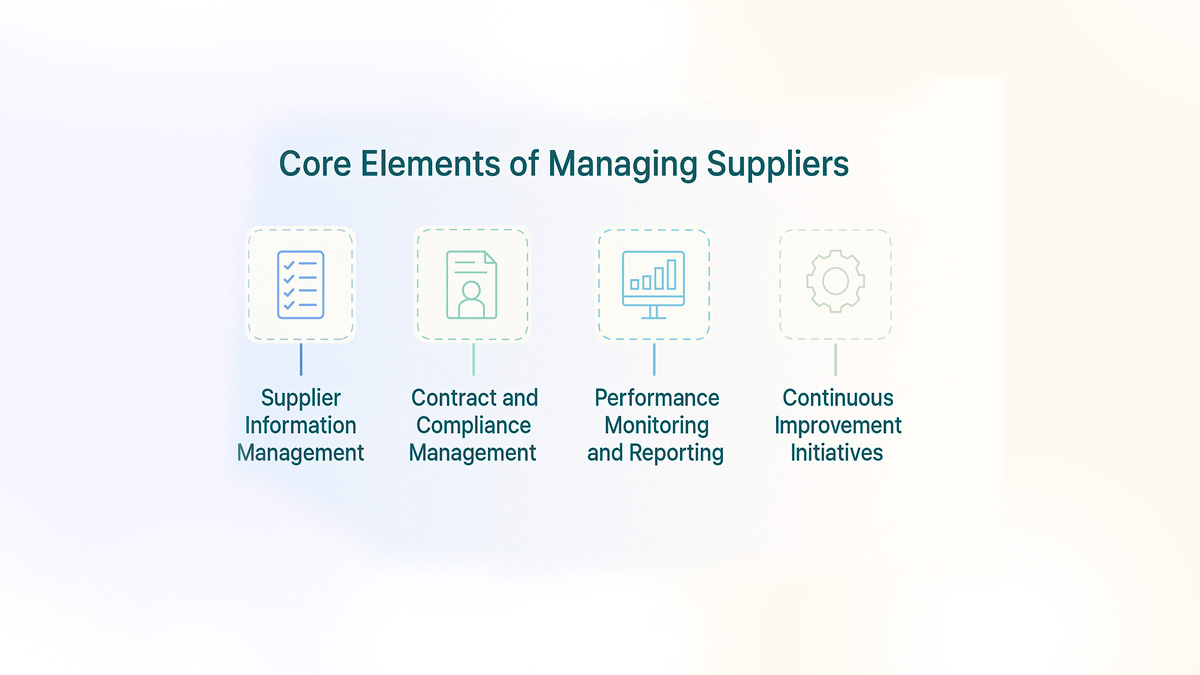

Supplier Management - The Comprehensive Guide

Supplier Management - The Comprehensive Guide
Master supplier management strategies to enhance relationships, performance, and risk control across your supply chain.


In today’s global market, supplier management plays a critical role in ensuring businesses operate smoothly and competitively. From securing reliable sources of goods and services to fostering strong partnerships, effective supplier management helps organizations reduce costs, mitigate risks, and improve operational efficiency. It’s not just about managing vendors - it’s about building a resilient, value-driven supply chain.
What this blog will cover:
- What is supplier management?
- The importance of supplier management in procurement and operations
- Key components of an effective supplier management process
- Supplier lifecycle management: from onboarding to offboarding
- Strategies to build stronger supplier relationships
- How to evaluate and monitor supplier performance
- Common challenges in supplier management and how to overcome them
- How Spendflo helps with supplier management
- Frequently asked questions on supplier management
What is Supplier Management?
Supplier management is the strategic process of selecting, onboarding, monitoring, and developing suppliers to ensure quality, cost-efficiency, and compliance. It helps businesses reduce risks, enhance performance, and build long-term, value-driven relationships that align with organizational goals and operational needs.
The Importance of Supplier Management in Procurement and Operations
Effective supplier management ensures that procurement teams secure the best value while maintaining quality and compliance. It creates a structured approach for supplier engagement, enabling organizations to strengthen their supply chains, optimize costs, and adapt quickly to market changes.
Here are the key reasons supplier management is essential in procurement and operations:
Enhances Supply Chain Reliability
A well-managed supplier network ensures timely delivery of goods and services, reducing the risk of delays or shortages. This reliability keeps production lines running and customer satisfaction high.
Drives Cost Savings and Value Creation
Through strategic sourcing, bulk negotiations, and performance monitoring, businesses can identify opportunities for cost reduction. They can do this without sacrificing quality, ultimately boosting profit margins. Strong supplier management is essential to effective supply chain management.
Improves Supplier Relationships and Collaboration
Supplier management encourages transparent communication, trust, and long-term partnerships. Strong relationships foster innovation, flexibility, and mutually beneficial outcomes.
Supports Risk Mitigation and Compliance
By assessing financial stability, compliance records, and operational capacity, companies can identify potential risks early. This allows them to implement measures to ensure regulatory adherence and ethical practices. Supplier risk management prepares businesses for unexpected challenges.
Key Components of an Effective Supplier Management Process
A strong supplier management process is essential for building a reliable, cost-efficient, and resilient supply chain. It brings structure to every stage of supplier engagement - from information collection and contract creation to performance monitoring and continuous improvement. When executed well, it not only ensures suppliers meet your expectations but also enables both parties to achieve long-term growth.

Supplier Information Management
Centralizing supplier data is the foundation of effective management. This includes maintaining up-to-date records on company profiles, certifications, compliance documents, pricing, and performance history. A single, accurate source of supplier information improves decision-making, speeds up onboarding, and supports audit readiness.
Contract and Compliance Management
Contracts define the scope, terms, and responsibilities for both parties. Strong supplier management involves creating detailed agreements that include service level expectations, delivery timelines, pricing terms, and compliance requirements. Regular compliance checks ensure adherence to legal, ethical, and industry standards, protecting the organization from regulatory risks.
Performance Monitoring and Reporting
Ongoing monitoring of supplier performance through KPIs such as on-time delivery rates, defect percentages, and responsiveness helps ensure accountability. Regular performance reviews allow procurement teams to address issues promptly, recognize high performers, and maintain consistent quality across the supply base.
Continuous Improvement Initiatives
Supplier management should be forward-looking. By fostering a culture of continuous improvement, organizations can work with suppliers to identify cost-saving opportunities, adopt innovative technologies, and improve processes. Quality control safeguards compliance and customer satisfaction. This collaboration strengthens partnerships, enhances agility, and ensures the supply chain evolves with market demands.
A well-structured supplier management process isn’t static - it’s a cycle of evaluation, feedback, and enhancement that maximizes supplier value over time.
Supplier Lifecycle Management: From Onboarding to Offboarding
Managing a supplier’s journey from initial engagement to final contract closure ensures consistency, compliance, and value delivery at every stage.
Supplier selection and qualification
Begin by identifying strategic suppliers who meet your quality, pricing, capacity, and compliance needs. Conduct thorough due diligence, including financial checks and capability assessments, to ensure alignment with business requirements.
Contract negotiation and onboarding
Negotiate terms that balance cost, quality, and risk management. The onboarding phase should include sharing expectations, service levels, and performance metrics to establish a foundation for success.
Performance evaluation and development
Use KPIs and regular performance reviews to monitor supplier output. Collaborate on improvement plans, offer feedback, and provide resources for skill or process enhancement.
Renewal or offboarding processes
Evaluate performance and business needs before renewal. If offboarding is necessary, ensure a structured transition to avoid operational disruptions and maintain continuity.
Strategies to Build Stronger Supplier Relationships
Strong supplier relationships are the cornerstone of a resilient and value-driven supply chain. They go beyond transactional interactions, focusing instead on mutual trust, transparency, and shared objectives. Organizations that invest in their supplier relationships often benefit from better pricing, improved quality, faster problem resolution, and innovative collaboration.
Foster Transparent Communication
Open and honest communication is the foundation of any strong partnership. Businesses should clearly share expectations, timelines, and potential challenges while encouraging suppliers to voice their own needs and concerns. This two-way dialogue helps resolve issues quickly and prevents misunderstandings that can disrupt operations.
Invest in Long-term Partnerships
Rather than constantly switching suppliers for small cost advantages, companies can create stability and reliability by building long-term relationships with trusted vendors. Over time, these partnerships lead to better deals, priority service, and a willingness from suppliers to go the extra mile in times of need.
Leverage Technology for Collaboration
Digital platforms such as supplier portals, shared dashboards, and real-time communication tools make it easier to exchange information, monitor performance, and coordinate projects. Technology also helps track KPIs and compliance, ensuring both sides remain aligned on goals.
Align Goals for Mutual Growth
The most productive supplier relationships happen when both parties work toward shared objectives - whether it’s improving sustainability, expanding into new markets, or launching innovative products. Aligning strategic goals fosters cooperation and creates opportunities for joint value creation.
By adopting these strategies, businesses can move from transactional supplier management to strategic partnerships that strengthen the entire supply chain and deliver lasting competitive advantages.
How to Evaluate and Monitor Supplier Performance
Regular performance evaluation ensures suppliers meet agreed standards and adapt to evolving business needs.

Define Clear KPIs and Metrics
Set measurable indicators like on-time delivery rates, defect percentages, and order accuracy. Clear benchmarks keep suppliers accountable and provide a consistent basis for evaluation.
Use regular Performance Reviews
Conduct quarterly or biannual reviews to assess progress against KPIs. These meetings are an opportunity to address gaps, reinforce strengths, and adjust expectations.
Incorporate Feedback Loops
Encourage open feedback from internal stakeholders who interact with suppliers daily. Real-time insights help identify issues early and improve relationships.
Adopt Supplier Scorecards
Use scorecards to track performance over time across key areas such as quality, cost, delivery, and compliance. Performance data supports better, faster supplier decisions. Supplier performance management ensures standards stay consistent over time. This data-driven approach supports objective decision-making.
Common Challenges in Supplier Management and How to Overcome Them
Even with strong processes, supplier management faces operational and strategic challenges.
Managing Supply Chain Disruptions
Geopolitical issues, natural disasters, or logistical failures can disrupt supply chains. Develop contingency plans, diversify suppliers, and maintain safety stock to minimize impact.
Dealing with Compliance and Regulatory Issues
Suppliers must meet legal, ethical, and environmental standards. Regular audits and compliance checks help avoid penalties and protect brand reputation.
Overcoming Communication Barriers
Time zones, language differences, or unclear processes can lead to misunderstandings. Standardize communication protocols and leverage translation tools or regional liaisons.
Addressing Data and Technology Gaps
Incomplete or outdated data can hinder decision-making. Invest in procurement technology that provides real-time supplier insights and centralizes information.
How Spendflo Helps with Supplier Management
Spendflo streamlines supplier management by providing a centralized platform for tracking performance, contracts, and compliance. Our procurement experts negotiate favorable terms, monitor supplier KPIs, and ensure alignment with your business goals. By combining technology with expert-led strategy, Spendflo helps you reduce risks, improve collaboration, and maximize supplier value.
Frequently Asked Questions on Supplier Management
What are the benefits of supplier management?
Effective supplier management improves supply chain reliability, reduces costs, and enhances quality. It also strengthens relationships, mitigates risks, and ensures compliance, leading to long-term value creation and operational efficiency.
How does technology improve supplier management?
Technology centralizes supplier data, automates performance tracking, and streamlines communication. Tools like supplier portals and analytics dashboards provide real-time insights, enabling faster decisions and proactive issue resolution.
What are key factors to consider when selecting suppliers?
Key factors include product quality, pricing, financial stability, capacity, compliance with regulations, and cultural fit. A thorough evaluation ensures the supplier aligns with your operational and strategic goals.
How often should supplier performance be reviewed?
Performance should be reviewed quarterly or biannually, depending on the supplier’s criticality. Frequent reviews help address issues early, recognize achievements, and maintain alignment with business needs.
What challenges arise in supplier relationship management?
Common challenges include communication barriers, inconsistent quality, compliance issues, and supply chain disruptions. Proactive identification and mitigation of supplier risk ensures operational stability and reduces the likelihood of costly interruptions. Addressing these proactively through clear agreements, regular reviews, and collaborative problem-solving helps maintain strong relationships.
How do businesses ensure a strong supplier base while maintaining quality standards?
Building a strong supplier base starts with a rigorous supplier onboarding process that verifies capabilities, compliance, and alignment with quality standards. Ongoing monitoring of supplier quality through vendor relationships built on trust, combined with tracking performance via key performance indicators (KPI), ensures consistent results and a resilient supply chain.










.png)




.png)










.avif)





